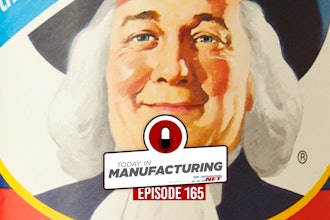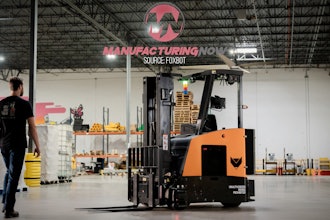Lean manufacturing. While you may think you have strategies in place to make you more efficient, you may be missing a big part of the picture.
2012 has come and gone. With a new year staring us down, it’s time for new resolutions. Resolutions involve change, which can be tough for manufacturers. Many manufacturers are conservative in their approach to changing IT solutions — solutions they have become extremely reliant upon and familiar with.
While some may believe they are well ahead of the game and have the best lean practices in place, they skipped one major exercise. No matter how efficient the rest of your business is, if your IT isn’t running at full speed, your end-to-end operations aren’t either. Whether it’s as simple as email or as complex as MRP, today’s businesses are driven by IT. Systems running at half speed or not at all can result in missed deadlines, lost revenues and reduced customer satisfaction. In some cases, it can even mean contractual or regulatory penalties. Whether downtime is planned or unplanned, many assume that a systems failure is a given; they will cross that bridge when they get there. What they don’t realize is that while the threat of downtime is always there, they can prevent it from happening by becoming proactive.
Crunching the Cost: What Does Downtime Cost Your Business?
In a nutshell — downtime is expensive. Improving IT availability is a perfect complement to lean initiatives. Downtime is tantamount to waste. By first determining what that waste will cost, you can then determine appropriate measures for eliminating it. This is not an easy feat, which is why figuring out the cost of downtime is avoided altogether by many businesses.
Several research firms have analyzed the cost of downtime across various industries. They determined that the bill can be $110,000 to $150,000 per hour (or higher). A study conducted by Coleman Parkes Research Ltd in 2010 found that the average manufacturer will lose more than $196,000 per year from systems outages. The costs don’t stop there. A stalled production line and idled workforce can’t just pick up exactly where they left off, and certainly not at full speed. The inefficiencies aren’t isolated to the line, either. Downtime reintroduces all sorts of waste into operations and spreads through the supply chain, top to bottom, like a virus. Administrative operations are ruffled, and suppliers are left scrambling. There’s also customers who won’t be happy to hear their order is delayed and may share their dissatisfaction on social media outlets.
Now What? Looking at High Availability Options
Once you’ve determined your downtime cost, what’s next? Now it’s time to look at your overarching IT infrastructure and determine what applications are most critical – in other words, when an outage strikes, what applications MUST be back online first? While the obvious answer is “all of them,” some applications require more protection than others. An easy way to look at this is to consider the “the nines” of availability and to match application uptime requirements with the best solution. The chart below does a great job of illustrating “the nines” of uptime. While yearly downtime could be a single instance or multiple, the cost remains. Often the cost of an outage is not factored into cost of goods sold, and is left to be absorbed by the company. Using this chart, you can assign an availability tier to an application.
Translating Downtime into Cost | ||||
Availability Level | Hours Unavailable | $10,000 cost/hour | $25,000 cost/hour | $100,000 cost/hour |
Standard | ||||
99.0% | 87.66 | $876,600 | $2,191,500 | $8,766,000 |
High | ||||
99.95% | 4.38 | $43,800 | $109,500 | $438,999 |
Continuous | ||||
99.99-99.999% | .00876 | $880 | $2,190 | $8,760 |
99.9999% | 0.00846 | $88 | $219 | $876 |
Sticking to it: High Availability without Complexity
More and more manufacturers are adopting virtualization software on the plant floor as a way to consolidate servers and applications, and reduce operating and maintenance costs. That said, virtualization does create a critical computing environment. By taking many applications and placing them on fewer servers, the impact of a server outage becomes greater. While virtualization can improve uptime, this software can do nothing to protect the underlying server from failing. And, you can’t migrate virtual machines off a flat-lined server. This reality may cause some to shy away from virtualizing critical applications. However, solutions such as high-availability software and fault-tolerant servers, which are designed to prevent downtime before it can strike, are options worth considering. Contrary to popular belief, these solutions are easy to use, manage and maintain. They are not server clusters, which can be complex and costly to use, and rely on failure recovery/restart.
Set it and Forget It
Time spent on the care and feeding of plant floor automation systems is time not spent of manufacturing workflows and production. It’s a distraction from the real business. Spending less time and fewer resources requires that IT operations be more simple, reliable and trouble-free. A change in mindset and behavior regarding lean initiatives can help manufacturers take the appropriate steps to implement the best solutions for critical shop floor applications, allowing them to sleep at night knowing they made (and stuck to) a worthwhile resolution.
Frank Hill is the director of manufacturing business development for Stratus Technologies. Prior to joining Stratus, Mr. Hill led MES business development at Wyeth, Merck & Co., and AstraZeneca for Rockwell Automation. He has also worked in manufacturing leadership at Merck & Company. He is a frequent speaker and commentator on technology-enabled manufacturing solutions.






















